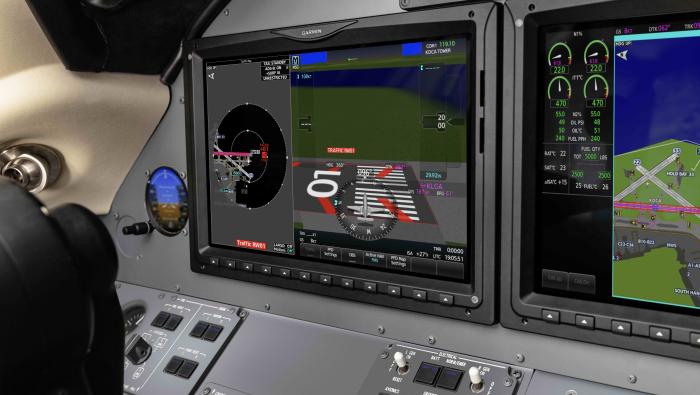|
Garmin’s Runway Occupancy Awareness (ROA) has been certified by the FAA, “marking the first certified software solution utilizing the Surface Indications and Alert (SURF-IA) technology,” according to the Olathe, Kansas avionics manufacturer. The first aircraft and initial certification of ROA is for the G1000 NXi-equipped Textron Aviation Cessna Caravan. ROA uses the equipped aircraft’s GPS position and ADS-B In traffic information to determine whether other aircraft (airborne or on the ground) or ground vehicles might cause a runway incursion or present a potential collision opportunity. The potential incursion or collision information is presented to the pilot as a visual crew-alerting system caution and warning announcement on the primary flight display (PFD) and by the runway highlighted in yellow or red on the PFD’s synthetic vision system. Similar caution and warning annunciations will be displayed on the SafeTaxi map on the multifunction display or window. Traffic that generates a potential hazard includes aircraft landing, taking off, stopped, or taxiing on the runway; aircraft on approach to the ROA-equipped aircraft’s runway or a crossing runway; and any traffic on the runway at which the ROA-equipped aircraft is holding. Warnings include visual and aural alerts and range from “no immediate collision hazard to a warning level alert where a collision risk could occur within 15 seconds.” |
|
|
Nextant Aerospace, working with Bombardier and SpaceX, has obtained FAA supplemental type certification (STC) and is offering kits for the installation of Starlink in-flight connectivity on a range of Globals. The kits can be installed at Bombardier service centers worldwide, and Nextant, the engineering arm of Flexjet, will provide dedicated 24/7 support. Kits are certified for the Bombardier Global Express, XRS, 6000, 6500, and 7500. The Starlink installation will provide passengers and crew with access to high-speed internet that approaches that of a terrestrial-based option, Nextant said. Starlink provides high-speed, low-latency internet globally using a constellation of more than 6,000 low-earth-orbit satellites. Flexjet became one of the first to adopt Starlink, obtaining FAA approval for installation on Gulfstream G650s last September. Since then, Flexjet’s Nextant division has expanded the STCs to cover the Globals, as well as the Gulfstream G550 and G450. Nextant further anticipates releasing STC kits for Bombardier Challengers by year-end. “Several years ago, we recognized the fact that reliable, high-speed connectivity was the most significant inflight experience that our industry still needed to solve for,” said Jay Heublein, president of Flexjet global maintenance and product support. “After over a year of research, it became clear to us that SpaceX, through Starlink, was going to finally be the solution our industry has been in search of for decades.” |
|
|
The International Aircraft Dealers Association's (IADA) newly-formed NextGen Committee has made a strong start in its first year, the U.S.-based organization reported this week. The group recently held a networking event in San Diego and provided an update on its efforts to nurture the next generation of business aircraft transaction professionals. Among the events organized by the committee in its inaugural year was the Business of Flight session staged jointly with Embry-Riddle Aeronautical University. NextGen committee vice chair Richard McEachin, who is an attorney with the Aviation Legal Group, and IADA-certified broker Kandi Spangler, who is JetAviva’s managing director, presented a session on ethics in aircraft transactions. To encourage connections between younger members, IADA has launched a series of virtual events. In the new “Fuel Stop” sessions, aviation sales veteran Dustin Cordier hosts 30-minute conversations with industry leaders who share their insights and knowledge. In its “Afterburner” events, IADA members can interact with NextGen Committee members to learn how they can use resources such as the community board portal, social media channels, and educational opportunities. Jordan Scales, director of aircraft management with Clay Lacy Aviation, has led the committee’s efforts to engage with students. He liaises closely with the Alpha Eta Rho fraternity to expand the list of universities and schools offering scholarships backed by the IADA Foundation. |
|
|
Universal Fuel Technologies (UFT) said its new sustainable aviation fuel (SAF) production pathway process could be an industry game-changer. The Los Altos, California-based company has developed flexiforming, a process that uses different feedstocks and even the byproducts from existing renewable fuel manufacturing processes to produce renewable fuels such as SAF. According to the company, its process has been tested on more than 50 different feedstocks, and it can also be integrated into existing SAF facilities, upgrading low-value byproducts into SAF and helping to drive down manufacturing costs. In addition, it claims that its flexiforming SAF—while not tested to ASTM standards—is drop-in ready. “This technology allows SAF producers to create a genuinely drop-in-ready renewable jet fuel due to the presence of all required molecules,” said UFT CEO Alexei Beltyukov. “For example, a SAF producer using HEFA, which only produces paraffinic SAF, could add flexiforming to their plant to convert naphtha and LPG byproducts to aromatic SAF that can be blended with the HEFA SAF for a fully synthetic jet fuel that can be sold directly without the need for blending with conventional jet fuel.” Beltyukov told AIN that the process is also energy efficient, using 75% less energy than existing ethanol-to-jet technologies, as well as 33% less hydrogen. The company expects to submit its process to ASTM by year-end, along with the first commercial application. |
|
|
The Saudi Arabian National Guard (SANG) has signed a five-year, $19 million support contract with MD Helicopters to support SANG’s 12 MD 530F flight training helicopters, which began service in 2013. Under the contract, which covers a base year and four optional years, MD Helicopters is supporting SANG with a field service representative and logistics technician based in Saudi Arabia, as well as more than $1 million worth of spare parts that will be delivered this month. According to MD Helicopters, the SANG fleet “was previously maintained by an in-country contractor. The department requested OEM support to increase the maintenance quality and material support. MD will provide direct support for the aircraft, which will improve maintenance and parts acquisition while reducing costs and downtime.” “The Saudi Arabian National Guard is a long-time MD customer, and it is our privilege to be their preferred partner for ensuring timely and cost-effective maintenance of the fleet,” said MD Helicopters president Ryan Weeks. “By working directly with MD, SANG will experience increased responsiveness, faster turn times, and higher quality work, which translates into time and money savings.” |
|
|
NATA has introduced a strategic marketing platform to link its members with experts, tools, and resources. Dubbed NATA Partner+, it comprises a network of industry brands and subject matter experts from the association’s membership that can assist with operational efficiencies and address local, tactical, and strategic issues specific to individual aviation businesses, the association said. This includes offering solutions for industry challenges, business growth platforms, and business intelligence for increased productivity. In addition, NATA Partner+ affiliates offer a range of discounts, free trials, waived fees, exclusive content, and educational training. “NATA members face both new and lingering challenges from looming changes to safety and security programs to lags in certification, increased market competition, and an evolving operational landscape with heightened community pressures. While many of these concerns are shared broadly, the solutions often vary by company or location,” stated NATA COO Keith DeBerry. Some of the resources available cover technologies for air charter communications, operations, and sales growth; software to support airport ground operations with a focus on operational efficiency and quality control; guides on developing and maintaining required security programs; expertise and guidance on certificate consolidations, approvals, and other regulatory matters; and training and tools for safety management systems. Initial NATA Partner+ participants include Hawthorn Hill, iReportSource, KGG, Levo, NDX, and Polaris Aero. |
|
|
The New South Wales Rural Fire Service (NSW RFS) is installing GPMS International’s Foresight MX health and usage monitoring system (HUMS) in its fleet of Sikorsky Black Hawk helicopters. The Black Hawks were transferred to the NSW RFS by Australia’s Department of Defence and they are used for aerial firefighting and emergency service. Areas covered by the NSW RFS include more than 800,600 sq km (309,000 sq m) of New South Wales “in one of the most fire-prone areas on earth,” according to GPMS. Adding Foresight MX HUMS to the Black Hawks gives the NSW RFS access to predictive aircraft and engine health, flight data, and exceedance monitoring as well as integrated rotor system track and balance features. “Equipping our Black Hawks with Foresight MX marries innovation and safety together,” said a NSW RFS spokesman. “The advanced remote monitoring will give our crews detailed insight into the health of the aircraft, no matter where they’re located, and ensure we’re flying safely and smoothly. This will allow us to better respond and support firefighting and emergency operations across the state." |
|
|
|
|
|
|
AINalerts News Tips/Feedback: News tips may be sent anonymously, but feedback must include name and contact info (we will withhold name on request). We reserve the right to edit correspondence for length, clarity, and grammar. Send feedback or news tips to AINalerts editor Chad Trautvetter. |
|
AINalerts is a publication of AIN Media Group, 214 Franklin Avenue, Midland Park, New Jersey. Copyright 2023. All rights reserved. Reproduction in whole or in part without permission is strictly prohibited. |















